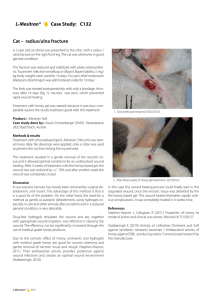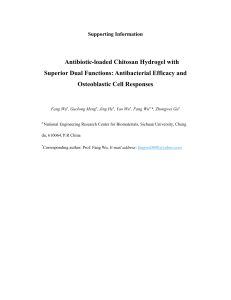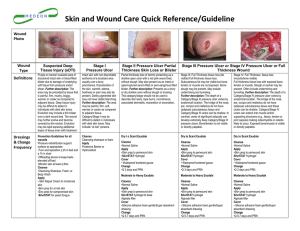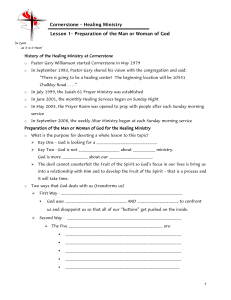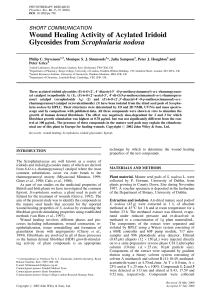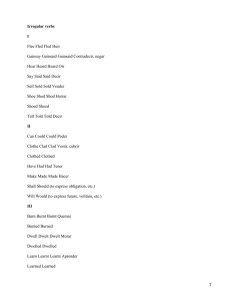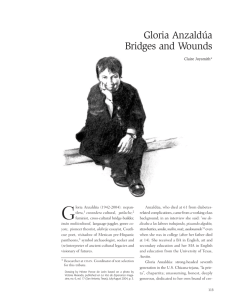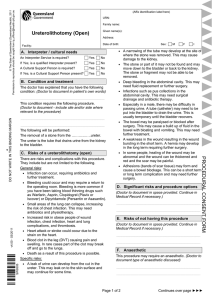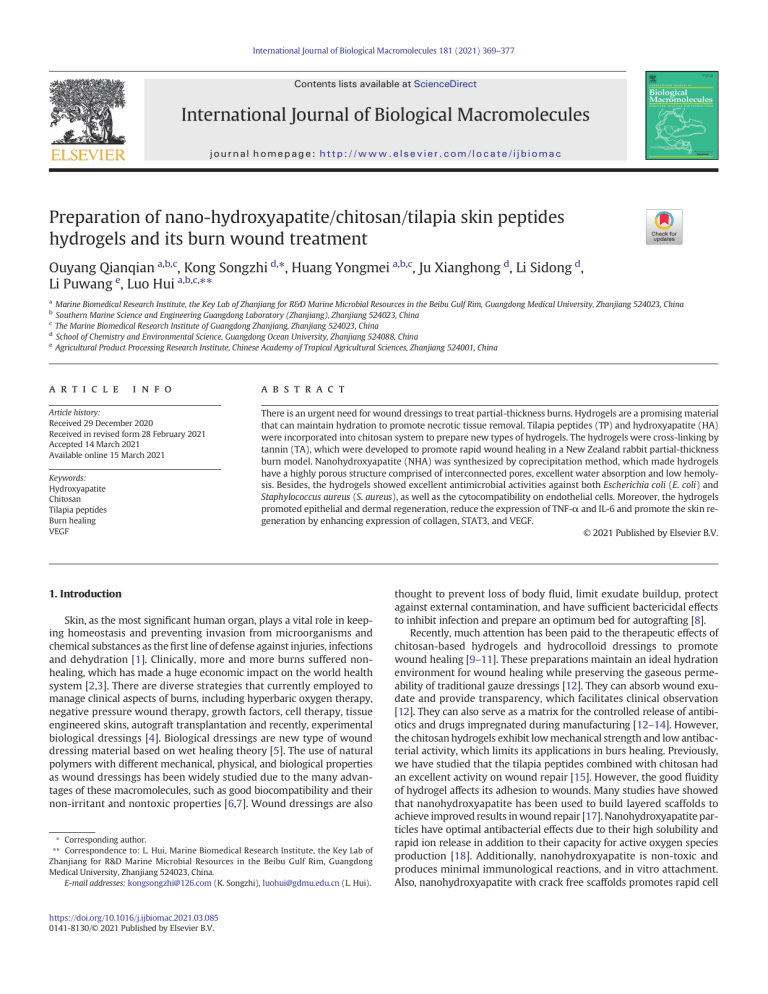
International Journal of Biological Macromolecules 181 (2021) 369–377 Contents lists available at ScienceDirect International Journal of Biological Macromolecules journal homepage: http://www.elsevier.com/locate/ijbiomac Preparation of nano-hydroxyapatite/chitosan/tilapia skin peptides hydrogels and its burn wound treatment Ouyang Qianqian a,b,c, Kong Songzhi d,⁎, Huang Yongmei a,b,c, Ju Xianghong d, Li Sidong d, Li Puwang e, Luo Hui a,b,c,⁎⁎ a Marine Biomedical Research Institute, the Key Lab of Zhanjiang for R&D Marine Microbial Resources in the Beibu Gulf Rim, Guangdong Medical University, Zhanjiang 524023, China Southern Marine Science and Engineering Guangdong Laboratory (Zhanjiang), Zhanjiang 524023, China The Marine Biomedical Research Institute of Guangdong Zhanjiang, Zhanjiang 524023, China d School of Chemistry and Environmental Science, Guangdong Ocean University, Zhanjiang 524088, China e Agricultural Product Processing Research Institute, Chinese Academy of Tropical Agricultural Sciences, Zhanjiang 524001, China b c a r t i c l e i n f o Article history: Received 29 December 2020 Received in revised form 28 February 2021 Accepted 14 March 2021 Available online 15 March 2021 Keywords: Hydroxyapatite Chitosan Tilapia peptides Burn healing VEGF a b s t r a c t There is an urgent need for wound dressings to treat partial-thickness burns. Hydrogels are a promising material that can maintain hydration to promote necrotic tissue removal. Tilapia peptides (TP) and hydroxyapatite (HA) were incorporated into chitosan system to prepare new types of hydrogels. The hydrogels were cross-linking by tannin (TA), which were developed to promote rapid wound healing in a New Zealand rabbit partial-thickness burn model. Nanohydroxyapatite (NHA) was synthesized by coprecipitation method, which made hydrogels have a highly porous structure comprised of interconnected pores, excellent water absorption and low hemolysis. Besides, the hydrogels showed excellent antimicrobial activities against both Escherichia coli (E. coli) and Staphylococcus aureus (S. aureus), as well as the cytocompatibility on endothelial cells. Moreover, the hydrogels promoted epithelial and dermal regeneration, reduce the expression of TNF-α and IL-6 and promote the skin regeneration by enhancing expression of collagen, STAT3, and VEGF. © 2021 Published by Elsevier B.V. 1. Introduction Skin, as the most significant human organ, plays a vital role in keeping homeostasis and preventing invasion from microorganisms and chemical substances as the first line of defense against injuries, infections and dehydration [1]. Clinically, more and more burns suffered nonhealing, which has made a huge economic impact on the world health system [2,3]. There are diverse strategies that currently employed to manage clinical aspects of burns, including hyperbaric oxygen therapy, negative pressure wound therapy, growth factors, cell therapy, tissue engineered skins, autograft transplantation and recently, experimental biological dressings [4]. Biological dressings are new type of wound dressing material based on wet healing theory [5]. The use of natural polymers with different mechanical, physical, and biological properties as wound dressings has been widely studied due to the many advantages of these macromolecules, such as good biocompatibility and their non-irritant and nontoxic properties [6,7]. Wound dressings are also ⁎ Corresponding author. ⁎⁎ Correspondence to: L. Hui, Marine Biomedical Research Institute, the Key Lab of Zhanjiang for R&D Marine Microbial Resources in the Beibu Gulf Rim, Guangdong Medical University, Zhanjiang 524023, China. E-mail addresses: [email protected] (K. Songzhi), [email protected] (L. Hui). https://doi.org/10.1016/j.ijbiomac.2021.03.085 0141-8130/© 2021 Published by Elsevier B.V. thought to prevent loss of body fluid, limit exudate buildup, protect against external contamination, and have sufficient bactericidal effects to inhibit infection and prepare an optimum bed for autografting [8]. Recently, much attention has been paid to the therapeutic effects of chitosan-based hydrogels and hydrocolloid dressings to promote wound healing [9–11]. These preparations maintain an ideal hydration environment for wound healing while preserving the gaseous permeability of traditional gauze dressings [12]. They can absorb wound exudate and provide transparency, which facilitates clinical observation [12]. They can also serve as a matrix for the controlled release of antibiotics and drugs impregnated during manufacturing [12–14]. However, the chitosan hydrogels exhibit low mechanical strength and low antibacterial activity, which limits its applications in burs healing. Previously, we have studied that the tilapia peptides combined with chitosan had an excellent activity on wound repair [15]. However, the good fluidity of hydrogel affects its adhesion to wounds. Many studies have showed that nanohydroxyapatite has been used to build layered scaffolds to achieve improved results in wound repair [17]. Nanohydroxyapatite particles have optimal antibacterial effects due to their high solubility and rapid ion release in addition to their capacity for active oxygen species production [18]. Additionally, nanohydroxyapatite is non-toxic and produces minimal immunological reactions, and in vitro attachment. Also, nanohydroxyapatite with crack free scaffolds promotes rapid cell O. Qianqian, K. Songzhi, H. Yongmei et al. International Journal of Biological Macromolecules 181 (2021) 369–377 2.4. Preparation of NHA/CS/TP composite hydrogels proliferation, spreading, rapid bioabsorption and bone regeneration in short time [19]. Given that incorporating nanohydroxyapatite (NHA) into the chitosan hydrogel is able to generate a new type of hydrogel with cross-linking by tannic acid to improve strength, it will be feasible to use the hydrogel for wound healing. With nanohydroxyapatite as the scaffold to form a stable hydrogel skeleton structure, it would be conducive to the effective components of the hydrogel and the effect of the burn tissue, accelerate the repair of the burn tissue. In the present study, we firstly prepared NHA by the method of coprecipitation. Then the chitosan (CS) hydrogel was prepared by incorporating NHA and tilapia peptides (TP) into the hydrogel system. In order to improve the mechanical properties and antibacterial properties, the hydrogels were cross-linking by tannic acid. The morphological, water absorption, biocompatibility and antibacterial activity of hydrogels were also evaluated. Moreover, New Zealand rabbit back burn model was established to assess the potential of NHA/CS/TP hydrogels as burns dressing. NHA/CS/TP composite hydrogels were prepared as follows. Briefly, CS (2.0 g) and TP (3.0 g) were dissolved in 95 g of acetic acid (w/v, 1%) under continuous stirring to obtain a mixture solution with a final concentration of 5% (CS/TP). Varied amounts of HA (0.5% (I) and 1.0% (II) (w/w)) were added to the CS/TP solution to produce two kinds of mixtures, respectively. Then, the mixtures were added to the tannin solution (5 w/v%) for crosslinking. Finally, the mixture was stirred for 1 h, and poured into a mold coated with PTFE, which was then first frozen for 24 h at −80 °C. To prepare the porous hydrogels, the frozen gels were lyophilized using a freeze drier for 48 h at −54 °C. The composite hydrogels were then unloaded from the mold, named NHA/CS/TP (I) and NHA/CS/TP(II), respectively. 2.5. Hydrogel characterization 2.5.1. Morphological properties The sample was frozen and brittle-broken in liquid nitrogen. The ultrastructure of NHA/CS/TP(I) and NHA/CS/TP(II) were analyzed by scanning electron microscope (SEM, S-4800, Japan). 2. Materials and methods 2.1. Materials 2.5.2. Water absorption ability The water absorption ability of all the samples was tested. The water absorption capacity test was conducted according to the previous method [20]. NHA/CS/TP(I) and NHA/CS/TP(II) in dryness were accurately weighed and recorded as M0. The samples were immersed in 37 °C water for 30 min, and the wet samples were put on the filter paper to absorb excess water. Then the wet samples were weighed and recorded as M1, and the dry samples were weighed and recorded as M0. Where X is stand for water absorption. The water absorption ability of the samples was calculated as: CS (average molecular weight = 100 kDa, degree of deacetylation ≥ 90%), was purchased from Qingdao Bozhi Huili Biotechnology Co., Ltd. (Qingdao, China). TP were prepared by our laboratory as described below, and its molecular was 500–1000 Da. Tannic acid, Ca (NO 3 )2 ·4H2 O, (NH4 ) 2HPO4 , NH3 ·H2O were of analytical grade. Burn cream (abbreviated MEBO) was purchased from MEBO Pharmaceuticals Co., Ltd. (Shantou, Guangdong, China). Tumor necrosis factor-α (TNF-α) and interleukin-6 (IL-6) were measured by enzymelinked immunosorbent assay (ELISA) kits, obtained from eBioscience (San Diego, CA, USA). STAT3 (#ab68153), VEGF (#ab27278) and immunoglobulin G- fluorescein isothiocyanate (IgG-FITC) were purchased from abcam (Cambridge, UK). X¼ M1−M0 100% M0 All experiments were done at least in triplicate. 2.2. Preparation of hydroxyapatite (HA) 2.5.3. Hemolytic tests Hemolytic tests were performed using rabbit hemocyte suspension according to the reference [18]. Each sample (NHA/CS/TP(I) and NHA/ CS/TP(II)) was put into double distilled water for 24 h to obtain the material extract. 5 mL of material extract was mixed with 5 mL of 2% rabbit hemocyte suspension (diluted with 0.9% NaCl solution (NS)), followed by incubating at 37 °C for 3 h. Then the hemocyte suspensions were centrifuged at 1600 rpm for 10 min and detected on a UV/Vis spectrophotometer at 545 nm to determine the hemolytic ratio. Double distilled water was employed as a positive control while normal saline (NS) was employed as a negative control. The hemolytic ratio was calculated according to the following equation: Hydroxyapatite (HA) was synthesized by co-precipitation at room temperature according to a modified method described by Zhou et al. [17]. 200 mg of Ca (NO 3) 2 ·4H2O was dissolved in 350 mL of anhydrous ethanol to obtain a homogeneous solution with a concentration of 0.2 M, and 5.52 g of (NH4)2 HPO 4 was dissolved in 210 mL of ultrapure water under simultaneous stirring to obtain a homogeneous solution with a concentration of 0.2 M. The pH of the two solutions was adjust with 25% of NH3·H2O to about 11. Then, (NH4)2HPO4 solution was added dropwise into Ca (NO3) 2 ·4H 2 O solution under simultaneous stirring. During the dripping process, 25% of NH3·H2O solution was used to adjust the pH value of the mixture, so that the pH value was always maintained at about 10.5–11. After dripping, the mixture was stirred at a constant speed for 24 h to disperse evenly, and then allowed to stand at room temperature for 24 h to passivate the mixture. The mixture was purified using a 0.22 μm filter membrane and washing with ultrapure water until pH was neutral. The filtered white hydroxyapatite was placed in a drying oven at a constant temperature of 60 °C overnight, and the dried samples were ground into a fine powder with a mortar for later use, called nanohydroxyapatite (NHA). A¼ T−N 100% P−N where A is hemolytic ratio, T is the absorbance for the test sample, N is the absorbance for the negative control, P is the absorbance for the positive control. 2.5.4. Antibacterial assay The in vitro antibacterial assessment of hydrogels was examined against using a representative Gram-negative Escherichia coli (E. coli, ATCC25922) and a representative Gram-positive Staphylococcus aureus (S. aureus, ATCC25723) as model microorganisms. Briefly, bacterial cells were cultivated in Mueller-Hinton broth (MHB) overnight at 37 °C with 200 rpm in a shaker. Subsequently, 1 mL of bacterial suspension with concentrations of 1 × 107 CFU/mL were introduced to the surface of 24-well sized hydrogel for incubation of 24 h at 37 °C. The 2.3. Structure characterization of HA The morphology of HA was viewed using high resolution transmission electron microscopy (HRTEM, JEOL, Japan). Before the visualization, HA was prepared by ultrasonic suspension in ethanol, then supported on a Cu grid. X-ray diffraction (XRD) patterns of HA particles and gel power samples were recorded on an X-ray diffractometer (Bruker D8 Advance). 370 O. Qianqian, K. Songzhi, H. Yongmei et al. International Journal of Biological Macromolecules 181 (2021) 369–377 manufacturer's instructions (Jiancheng Inst. of Biotechnology, Nanjing, China). The level of hydroxyproline in the skin, which positively correlates with dermal collagen, was measured using in skin samples (~100 mg each) by ELISA kit according to the manufacturer's instructions (Jiancheng Inst. of Biotechnology, Nanjing, China). aliquots of culture medium and bacterial-attached hydrogel were transferred into sterilized tube containing 5 mL PBS and shook for 10 min followed by a series of dilution, and then mixed solution was spread on Luria-Bertani agar plates. The number of colonies was counted Using a colony counter (Czone 7D, Hangzhou Xunshu Technology Co., Ltd., China) after incubation for 24 h in an anaerobic chamber. 2.10. The assessment of TNF-α and IL-6 2.6. Cytocompatibility evaluation To prepare skin extracts for ELISAs, 0.3 g of each sample was homogenized (10,000 rpm, 20 s) with 9 times the volumes of PBS (4 °C) to produce 10% homogenate, which was centrifuged at 3000 rpm for 20 min at 4 °C. The supernatant was employed to estimate the TNF-α and IL-6 levels with ELISA kits (eBioscience) in accordance with the specifications. The proliferation of HUVECs was assessed using CCK-8 assay. Briefly, HUVECs were counted under a microscope using a hematocytometer, and a concentration of 5 × 103 cells/mL was prepared in complete media. Then, HUVECs were seeded in the 96-well plate. After 24 h of cell adherence, the culture medium was replaced with different concentrations of samples. The samples were grouped as follows: (1) blank control (control), (2) NHA/CS/TP(I), (3) NHA/CS/TP(II). After 24 h, 48 h and 72 h, cell viability was measured by CCK-8 assay. Then 100 μL of supernatants was extracted and read at 450 nm using a plate reader (n = 3). 2.11. Immunohistochemical examination The wounds and surrounding skin were harvested on day 21. Immunohistochemical staining as described by Huang et al. [21] was performed with rabbit antibodies against STAT3 (#ab68153, abcam), VEGF (#ab27278, abcam) and IgG-FITC (abcam). The fluorescent images were collected with a CLSM as described above. The fluorescence intensities of stained sections were quantified using Image-pro plus 6.0 software. 2.7. Burns repair All animal procedures were performed in accordance with the guidelines and ethics approval of Experimental Animal Care and Use Committee of Guangdong Medical University. New Zealand rabbits were commercially supplied by Guangdong Medical Laboratory Animal Center (Foshan, China). The burns healing efficacies of composite films were evaluated using New Zealand rabbit back burn model. New Zealand rabbits were kept under monitored conditions at constant temperatures (25 ± 1 °C) with food and water ad libitum under a 12-h dark/light cycle. The dorsal hair of New Zealand rabbits was shaved and cleaned with 75% ethanol after anesthesia with 1.5% pentobarbital. The scald wounds (3 cm2) were created in the dorsal skin of each animal using a scalding temperature control instrument (YLS-5Q, Beijing Zhongshidichuang Science & Technology Development Co. Ltd., Beijing, China). Afterwards, MEBO, NHA/CS/TP(I) and NHA/CS/TP(II) were applied to the burns. Burns treated with no materials under the same conditions were served as the control. After 3, 7, 14 and 21 days, photographs of burn areas were taken, and the burn size at each time point was determined by using Image J software (n = 5). Relative burn area was calculated using the following formula: S¼ 2.12. Statistical analysis The data were processed with IBM SPSS Statistics 22 software (IBM Corp., Armonk, NY, USA) and analyzed using independent-samples ttests. Numerical data are expressed as mean ± SD, and differences among groups were analyzed using one-way analysis of variance. Differences were considered significant at p < 0.05. 3. Results and discussions 3.1. Characterization of hydroxyapatite The hydroxyapatite particles were characterized by XRD and TEM, and the results were shown in Fig. 1. TEM images show that dispersed HA crystals have different morphology, usually in the form of stick. At the same time, some HA crystals form fusiform or irregular aggregates. The size of HA crystals and their aggregates was tens of nanometers. The XRD patterns of HA crystals show strong diffraction peaks at 26.32°, 32.9°, and 34.1°, and these peaks correspond exactly to the overlapping diffraction of HA and the characteristic peaks of the lattice plane [17]. Nanohydroxyapatite is non-toxic with high mechanical strength and produces minimal immunological reactions, and in vitro attachment [22,23]. Also, nanohydroxyapatite with crack free scaffolds promotes rapid cell proliferation, spreading, rapid bioabsorption and bone regeneration in short time [19]. S0−S1 100% S0 Here, S0 represents the original burn area, S1 represents the unhealed burn area, and S represents relative wound area, respectively. 2.8. Histological and histometric analysis 3.2. Characterization of hydrogels After the New Zealand rabbits were euthanized at each time point, the surrounding skin and muscle around the wound area were extracted and fixed in 4% paraformaldehyde. Then the tissue samples were stained with hematoxylin and eosin (H&E) and observed under a fluorescence microscope (IX73, Olympus, Tokyo, Japan). The tissue samples on day 21 were stained with Masson's trichrome to analyze total collagen content (calculated as a percentage of the aniline blue staining in dermis). Stained slides were observed and photographed with a digital slice scanning system (Pannoramic MIDI, 3D HISTECH, Budapest, Hungary), and then quantified by Image-pro plus 6.0 software (Media Cybernetics, Inc., Rockville, MD, USA). The SEM image was used to microscopically observe the morphology of NHA/CS/TP-I and NHA/CS/TP-II hydrogels and evaluate their microstructure (Fig. 2A–B). The SEM image revealed that the prepared hydrogel had a highly porous structure comprised of interconnected pores. The pores of NHA/CS/TP-II are smaller and the voids are more uniform. The pore size was in the range of 42–86 μm, which was conducive to locking moisture and keeping a wet environment for wound healing and favorable for the cell attachment and migration. The results of water absorption are shown in Fig. 2C. The interactions between chitosan and water molecules could cause the polymer to be swelled while tannin protects the polymer from dissolution. While absorbing water, the swelling of hydrogels can provide a suitable environment for supporting cell survival, proliferation, and migration. The results showed that hydrogels had excellent water absorption, which 2.9. Total protein and hydroxyproline content estimation The level of total protein in the skin was measured using supernatant for skin tissue homogenization by ELISA kit according to the 371 O. Qianqian, K. Songzhi, H. Yongmei et al. International Journal of Biological Macromolecules 181 (2021) 369–377 Fig. 1. (A) The XRD pattern of HA; (B) the TEM image of HA. indicating that the dressing has good blood compatibility and high safety [25–27]. The compatibility of prepared wound dresser with blood cells, is regarded as a prerequisite for wound healing [28]. Hemolysis tests were conducted using 2% rabbit hemocyte suspension. The results were showed in Fig. 2D, obvious hemolysis was appeared in distilled water, but no evident hemolysis was detected in normal saline (NS). However, between NHA/CS/TP-I and NHA/CS/TP-II, low hemolysis was appeared, NHA/CS/TP-II showed better compatibility than NHA/CS/ TP-I with a hemolysis rate of 4.37%. is important to obtain a sustained drug delivery in the wound healing site [24]. Additionally, combined with SEM results, it can be seen that the NHA/CS/TP-II hydrogel had higher cross-linking degree and more compact spatial structure. The hemolysis rate acts as one way to evaluate the material biocompatibility. Wound healing dressings are usually indirect contact with wounds and blood, so the dressings must meet safety standards to prevent hemolysis after contact with blood. The lower the hemolysis rate of the dressing is, the less the ability to destroy red blood cells will be, Fig. 2. (A) The SEM image of NHA/CS/TP-I; (B) the SEM image of NHA/CS/TP-II; (C) the water absorption capacity of hydrogels; (D) the results of hemolysis tests of hydrogels; All values are expressed as the means ± SD for each group (n = 3). 372 O. Qianqian, K. Songzhi, H. Yongmei et al. International Journal of Biological Macromolecules 181 (2021) 369–377 Fig. 3. (A) Survival rate of E. coli after contact with different hydrogels for 24 h. (B) Survival rate of S. aureus after contact with different hydrogels for 24 h. All values are expressed as the means ± SD for each group (n = 3), * indicates significant difference from the control group, **p < 0.01. viability of NHA/CS/TP-II is significantly higher than NHA/CS/TP-I and the control group. However, in 72 h, the cell viability of NHA/CS/TP-II is significantly higher than the control group, while the cell viability of NHA/CS/TP-I is significantly lower than the control group. Therefore, during 72 h, NHA/CS/TP-II hydrogel has been suitable for cell proliferation and better compatibility due to its tremendous positive effect on cell growth. 3.3. Antibacterial property of hydrogels Since many failure cases in terms of biomaterials-based therapy are caused by bacterial infections, biomaterials with microbe inhibition currently are getting more attentions in clinic applications, particularly wound dressing. Thus, the antibacterial performance of as-prepared hydrogel in this study against two representative microbes (Gram-negative E. coli and Gram-positive S. aureus) was investigated in vitro. The results showed that, both NHA/CS/TP-I and NHA/CS/TP-II have excellent antibacterial properties (Fig. 3), however, the antibacterial performance of NHA/CS/TP-I and NHA/CS/TP-II does not have significant difference. Such excellent inherent antibacterial capacity in hydrogels can be ascribed to the combined antibacterial ability from chitosan, TA and HA. Therefore, the hydrogels are attractive for wound healing applications. 3.5. In vivo wound healing study of hydrogels After burn injury on the dorsal skin of New Zealand rabbits, we observed tissue softening, necrosis, edema, and interstitial fluid exudation with gradually expanding wound edges and red and swollen surrounding tissues (Fig. 5A). On day 3, the wounds remained soft and pale, with no scabbing but obvious suppuration. On day 7, no scabbing, but suppuration and obvious exudation of interstitial fluid were observed in the control group. In the other groups, the peripheral scabs began to come off, and the wound area was significantly smaller than in the control group. On day 14, the wounds were scabbed all groups, the peripheral scabs began to come off, and the area continued to reduce. The decreases in wound area were greater in the NHA/CS/TP-I and NHA/CS/ TP-II groups than in the control and MEBO groups. On day 21, the scabs had completely come off in the NHA/CS/TP-I and NHA/CS/TP-II groups but not in the control group. The best outcomes were observed in the NHA/CS/TP-II and MEBO groups, where hair began to grow in the wound area. The changes in healing rates of burn wounds in New Zealand rabbits over time are shown in Fig. 5B. On day 3, the healing rate of each group was negative as the wound area increased. On day 7, the wound area was smaller than on day 3, with the slowest healing rate was observed in the control group. The healing rate of the NHA/CS/TP-II group was significantly faster than in the control group, but not significantly different from the MEBO group. On day 14, the healing rates of the NHA/CS/TP-I and NHA/CS/TP-II groups were significantly faster than the control group. The healing rate of the NHA/CS/TP-II group was also significantly better than that of the MEBO group. The changes observed on day 21 were similar to that on day 14, and the NHA/CS/TP-II group healing rate was 5.40–24.47% higher than the other groups, which was significant. Wound healing is a complex process involving hemostasis, inflammation, cell proliferation and migration, angiogenesis, and remodeling [29]. To evaluate the growth rate and quality of regenerated tissues, histopathological analyses were performed on H&E-stained wound tissue. The results are shown in Fig. 5C. On day 14, there was still a moderate inflammatory reaction, the scabs had not come off, and epithelial regeneration was not obvious in the control and MEBO groups. By contrast, mild inflammation and extensive angiogenesis were observed in the NHA/CS/TP-I and NHA/CS/TP-II groups. Moreover, complete epidermal 3.4. Cytocompatibility of hydrogels For acting as a wound dressing, hydrogels that are biocompatible are a prerequisite in biomedical application. The cytocompatibility of hydrogels was examined using CCK-8 assay (Fig. 4). HUVECs were selected in this study because they play an essential role in wound healing. As displayed in Fig. 4, the results of cell viability showed hydrogels' good cytocompatibility. In 24 h, the cell viabilities of NHA/CS/TP-I and NHA/ CS/TP-II are both significantly higher than the control. In 48 h, the cell Fig. 4. The results of cytotoxicity tests. All values are expressed as the mean ± SD for each group (n = 3), * indicates significant difference from the control group, *p < 0.05. 373 O. Qianqian, K. Songzhi, H. Yongmei et al. International Journal of Biological Macromolecules 181 (2021) 369–377 Fig. 5. (A) Digital photos of burns that were covered with control (physiological saline solution), MEBO, NHA/CS/TP-I and NHA/CS/TP-II within 21 days; (B) percentage of burns size over time. Compared with control, *p < 0.05, **p < 0.01; compared with MEBO, #p < 0.05. Hydroxyproline is a precursor amino acid necessary for procollagen and collagen synthesis. As it indirectly reflects collagen content and is related to tissue healing ability, it is an important indicator for evaluating wound healing [31]. Changes in the hydroxyproline contents of granulation tissue after 21 days are shown in Fig. 6B. Compared with the control group, there was a significant increase in the NHA/CS/TP-II group (p < 0.05). Compared with the MEBO group, there were no differences in the NHA/CS/TP-I group, while a significant increase was observed in the NHA/CS/TP-II group (p < 0.05). These findings suggest that NHA/CS/TP-II increases hydroxyproline content in granulation tissue and promotes wound healing. TNF-α is an inflammatory factor produced by macrophages. IL-6 is a lymphokine produced by activated T cells and fibroblasts that activates acute response proteins and plays a pro-inflammatory role. Increased expression of TNF-α and IL-6 during wound healing can lead to an inflammatory imbalance in the body. TNF-α and IL-6 levels in the wound tissue at 21 days are shown in Fig. 6C and D. Both were decreased in the NHA/ regeneration was observed in the NHA/CS/TP-II group, suggesting that the formula promotes wound healing. 3.6. The expression of total protein, hydroxyproline, TNF-α and IL-6 The amount of protein synthesis directly affects the growth of granulation tissue and the final wound healing. Moreover, the total protein content in wound granulation tissue also reflects cell proliferation, with a higher total protein content indicating better granulation tissue growth [30]. Fig. 6A shows changes in total protein content in granulation tissue in each group at 21 days. Compared with the control group, total protein content in the granulation tissue was significantly increased in the NHA/ CS/TP-I and NHA/CS/TP-II groups (both p < 0.05). However, no significant differences with the MEBO group were observed in the NHA/CS/TP-I group, but there was a significant increase in the NHA/CS/TP-II group (p < 0.05). The result indicates that NHA/CS/TP-II promotes protein synthesis in granulation tissue and accelerates wound healing. 374 O. Qianqian, K. Songzhi, H. Yongmei et al. International Journal of Biological Macromolecules 181 (2021) 369–377 Fig. 6. (A) The content of total protein in wound tissues in each group; (B) the content of hydroxyproline in wound tissues in each group; (C) the expression of TNF-α in wound tissue; (D) the expression of IL-6 in wound tissue. Compared with the control group, *p < 0.05; compared with MEBO group, #p < 0.05; Data represent means ± SD, n = 6. CS/TP-II groups compared to the control group. Notably, STAT3 and VEGF expression in the NHA/CS/TP-II group were more similar to levels in the normal group. CS/TP-I and NHA/CS/TP-II groups, which showed the lowest expression with significant differences from the control and MEBO groups. This indicates that NHA/CS/TP-II reduces the local inflammatory response to promote wound healing. 4. Conclusions 3.7. The expression of collagen, STAT3 and VEGF In summary, hydroxyapatite crystals with particle size of tens of nanometers were synthesized by coprecipitation method. Then we have successfully fabricated a nanohydroxyapatite-reinforced NHA/CS/ TP-I and NHA/CS/TP-II hydrogels for burns healing. NHA/CS/TP-I and NHA/CS/TP-II hydrogels displayed porous structure that is similar to extracellular matrix (ECM). NHA/CS/TP-II hydrogel showed significantly water absorption, antibacterial, cytocompatibility, those of which were extremely beneficial for accelerating the process of burns healing. More importantly, NHA/CS/TP-II hydrogel promotes total protein synthesis in granulation tissue, substantially increases hydroxyproline content, reduces the local wound inflammatory response, accelerates angiogenesis and epithelialization, promotes collagen fiber production, and significantly increases STAT3 and VEGF expression, thereby promoting granulation tissue formation and burns healing. Therefore, NHA/CS/TP-II hydrogel has great potential as an ideal burns dressing to promote wound healing. Changes in collagen contents on day 21 were observed by Masson staining (Fig. 7). Collagen fibers are stained blue, and muscle fibers, cytoplasm, and red blood cells appear red. The collagen fibers were arranged in an orderly fashion with uniform density in the normal group (no burn) and the MEBO, NHA/CS/TP-I and NHA/CS/TP-II groups. By contrast, they were disordered in the control group. The collagen content (represented by average optical density) in the dermis layer of the burn wound was calculated, and the results were shown in Fig. 7. The average optical densities of collagen in the NHA/CS/TP-I and NHA/CS/TP-II groups were significantly higher than in the control and MEBO groups and similar to that in the normal group. The transcription factor STAT3 can bind to DNA and regulates multiple signal transduction pathways. VEGF is a key factor in angiogenesis that can serve as a highly specific mitogen to promote endothelial cell proliferation and induce angiogenesis. VEGF can also increase the release of angiogenetic factors by inducing macrophage chemotaxis, playing an important role in granulation tissue formation in the early stage of healing [32,33]. It has been reported that the promoter region of the VEGF gene has a binding site for STAT3, and continuous activation of STAT3 can induce VEGF expression [34]. As shown in Fig. 5, STAT3 and VEGF were expressed in the wounds in all groups 21 days after treatment. The expression levels of STAT3 and VEGF (represented by average optical density) in the wounds in each group were calculated with Image-plus 6.0 software. The results showed that the expression of both proteins was significantly higher in the NHA/CS/TP-I and NHA/ CRediT authorship contribution statement Qianqian Ouyang: Investigation, Methodology, Validation. Kong Songzhi: Conceptualization, Funding acquisition. Huang Yongmei: Software, Data curation, Validation. Ju Xianghong: Software, Validation. Li Sidong: Writing - Review & editing. Li Puwang: Supervision, Project administration, Resources. Luo Hui: Conceptualization, Funding acquisition, Writing- Review & editing, Project administration. 375 O. Qianqian, K. Songzhi, H. Yongmei et al. International Journal of Biological Macromolecules 181 (2021) 369–377 Fig. 7. (A) The expression of collagen, STAT3 and VEGF in normal skin (a) or wounds that were treated with physiological saline solution (b), MEBO (c), NHA/CS/TP-I (d) or NHA/CS/TP-II (e); (B) the mean densities of collagen content (compared with the control group, *p < 0.05 and **p < 0.01; Data represent means ± SD, n = 6); (C) the mean densities of STAT3 expression in each group on day 21 (compared with the control group, *p < 0.05; Data represent means ± SD, n = 6); (D) the mean densities of STAT3 expression in each group on day 21 (compared with the control group, *p < 0.05 and **p < 0.01; Data represent means ± SD, n = 6). Declaration of competing interest [6] S. Kordestani, M. Shahrezaee, M.N. Tahmasebi, H. Hajimahmodi, D.H. Ghasemali, M.S. Abyaneh, A randomized controlled trial on the effectiveness of an advanced wound dressing used in Iran, J. Wound Care 17 (2008) 323–327. [7] S. Thomas, A review of the physical. Biological and clinical properties of a bacterial cellulose wound dressing, J. Wound Care 17 (2008) 349–352. [8] J.S. Lee, Y.S. Cho, J.W. Lee, H.J. Kim, D.G. Pyun, M.H. Park, T.R. Yoon, H.J. Leen, Y. Kuroyanagy, Preparation of wound dressing using hydrogel polyurethane foam, Trends Biomater. Artif. Organs 15 (2001) 4–6. [9] K. Murakami, H. Aoki, S. Nakamura, S. Nakamura, M. Takikawa, M. Hanzawa, S. Kishimoto, H. Hattori, Y. Tanaka, T. Kiyosawa, Y. Sato, M. Ishihara, Hydrogel blends of chitin/chitosan, fucoldan and alginate as healing-impaired wound dressings, Biomaterials 31 (2010) 83–90. [10] K. Obara, M. Ishihara, T. Ishizuka, M. Fujita, Y. Ozeki, T. Maehara, Y. Saito, H. Yura, T. Matsui, H. Hattori, M. Kikuchi, A. Kurita, Photocrosslinkable chitosan hydrogel containing fibroblast growth factor-2 stimulates wound healing in healing-impaired db/db mice, Biomaterials 24 (2003) 3437–3444. [11] H. Chen, X. Xing, H. Tan, Y. Jia, T. Zhou, Y. Chen, Z. Ling, X. Hu, Covalently antibacterial alginate-chitosan hydrogel dressing integrated gelatin microspheres containing tetracycline hydrochloride for wound healing, Mat. Sci. Eng. C 70 (2017) 287–295. [12] J.S. Boateng, K.H. Matthews, H.N. Stevens, G.M. Eccleston, Wound healing dressings and drug delivery systems: a review, J. Pharm. Sci. 97 (2008) 2892–2923. [13] C. Rigo, M. Roman, I. Munivrana, V. Vindigni, B. Azzena, C. Barbante, W.R.L. Cairns, Characterization and evaluation of silver release from four different dressings used in burns care, Burns 38 (2012) 1131–1142. [14] E.Y. Teo, S.Y. Ong, M.S. Chong, Z. Zhang, J. Lu, S. Moochhala, M. Bow Ho, S.W. Teoh, Polycaprolactone-based fused deposition modeled mesh for delivery of antibacterial agents to infected wounds, Biomaterials 32 (1) (2011) 279–287. [15] Q. Ouyang, Z. Hu, Z. Lin, W. Quan, Y. Deng, S. Li, P. Li, Y. Chen, Chitosan hydrogel in combination with marine peptides from tilapia for burns healing, Int. J. Bio. Macromol. 112 (2018) 1191–1198. [17] X. Liu, Q. Huang, Y. Chen, A novel thermo-sensitive hydrogel based on thiolated chitosan/hydroxyapatite/beta-glycerophosphate, Carbohydr. Polym. 110 (2014) 62–69. The authors declare no conflict of interest. Acknowledgments This work was supported financially by Project of Science and Technology Plan of Guangdong Province (2017A010103023, 2018A030307015), the National Natural Science Foundation of China (No. 81803684), the Guangdong University Youth Innovation Talent Project(2020KQNCX023), the public service platform of south China Sea for R&D marine biomedicine resources (2017C8A), the Fund of Southern Marine Science and Engineering Guangdong Laboratory (Zhanjiang) (ZJW-2019-007), the Science and Technology Program of Guangdong Province (2019B090905011). References [1] Q. Zhou, H. Kang, M. Bielec, X. Wu, Q. Cheng, W. Wei, H. Dai, Influence of different divalent ions cross-linking sodium alginate-polyacrylamide hydrogels on antibacterial properties and wound healing, Carbohydr. Polym. 197 (2018) 292–304. [2] M. Olsson, K. Jarbrink, U. Divakar, R. Bajpai, Z. Upton, A. Schmidtchen, J. Car, The humanistic and economic burden of chronic wounds: a systematic review, Wound Repair Regen. 27 (2019) 114–125. [3] C.D. Weller, V. Team, G. Sussman, First-line interactive wound dressing update: a comprehensive review of the evidence, Front. Pharmacol. 11 (2020) 155. [4] M.G. Jeschke, S. Rehou, M.R. McCann, S. Shahrokhi, Allogeneic mesenchymal stem cells for treatment of severe burn injury, Stem Cell Res Ther 10 (2019), 337. [5] K.C. Broussard, J.G. Powers, Wound dressings: selecting the most appropriate type, Am. J. Clin. Dermatol. 14 (2013) 449–459. 376 O. Qianqian, K. Songzhi, H. Yongmei et al. International Journal of Biological Macromolecules 181 (2021) 369–377 [27] J.Y. Liu, Y. Li, G. Cheng Hu, E. Ye, C. Shen, F.J. Xu, Hemostatic porous sponges of ceosslinked hyaluronic acid/cationized dextran by one self-foaming process, Mater. Sci. Eng. C 83 (2018) 160–168. [28] H. Cheng, C. Li, Y. Jiang, B. Wang, F. Wang, Z. Mao, H. Xu, L. Wang, X. Sui, Facile preparation of polysaccharide-based sponges and their potential application in wound dressing, J. Mater. Chem. B 6 (4) (2018) 634–640. [29] L. Ding, X. Shan, X. Zhao, X. Zha, H. Chen, X. Wang, J. Cai, C. Wang, X. Li, G. Hao, J. Yu, G. Li, Spongy bilayer dressing composed of chitosan-Ag nanoparticles and chitosanBletilla striata polysaccharide for wound healing applications, Carbohydr. Polym. 157 (2017) 1538–1547. [30] Y.S. Zhang, X.B. Fu, P. Wang, Effects of guaichuang paste on the healing of surface ulcers in experimental animals, J. Exter. Thera. Tradit. Chin. Med 6 (16) (2007) 5–6. [31] J. Tian, J. Lv, Determination of the content of hydroxy proline in liver tissue by RPHPLC in rats with hepatic fibrosis, China Pharm. 3 (14) (2003) 145–147. [32] H. Li, J. Chang, Bioactive silicate materials stimulate angiogenesis in fibroblast and endothelial cell co-culture system through paracrine effect, Acta Biomater. 9 (6) (2013) 6981–6991. [33] W. Zhai, H. Lu, L. Chen, X. Lin, Y. Huang, K. Dai, K. Naoki, G. Chen, J. Chang, Silicate bioceramics induce angiogenesis during bone regeneration, Acta Biomater. 8 (2012) 341–349. [34] M. Zhao, F.H. Gao, J.Y. Wang, F. Liu, H.H. Yuan, W.Y. Zhang, B. Jiang, JAK2/ STAT3 signaling pathway activation mediates tumor angiogenesis by upregulation of VEGF and bFGF in non-small-cell lung cancer, Lung Cancer 73 (3) (2011) 366–374. [18] S. Seyedmajidi, R. Rajabnia, M. Seyedmajidi, Evaluation of antibacterial properties of hydroxyapatite/bioactive glass and fluorapatite/bioactive glass nanocomposite foams as a cellular scaffold of bone tissue, J. Lab. Phys. 10 (3) (2018) 265–270. [19] O.O. Ige, L.E. Umoru, S. Aribo, Natural products: a minefield of biomaterials, ISRN Mater. Sci. (2012) 1–20. [20] T. Yan, F. Cheng, X. Wei, Y. Huang, J. He, Biodegradable collagen sponge reinforced with chitosan/calcium pyrophosphate nanoflowers forrapid hemostasis, Carbohydr. Polym. 170 (2017) 271–280. [21] R. Huang, W. Li, X. Lv, Z. Lei, Y. Bian, H. Deng, H. Wang, J. Li, X. Li, Biomimetic LBL structures nanofibrous matrices assembled by chitosan/collagen for promoting wound healing, Biomaterials 53 (2015) 58–75. [22] D. Lee, E.J. Choi, S.E. Lee, K.L. Kang, H.J. Kim, Y.H. Youn, D.N. Heo, S.J. Lee, H. Nah, Injectable biodegradable gelatin-methacrylate/β-tricalcium phosphate composite for the repair of bone defects, Chem. Eng. J. 365 (2019) 30–39. [23] C. Zhao, N.T. Qazvini, M. Sadati, Z. Zeng, S. Huang, D. Losada, L. Zhang, Y. Feng, W. Liu, B. Huang, A pH-triggered, self-assembled, and bioprintable hybrid hydrogel scaffold for mesenchymal stem cell based bone tissue engineering, ACS Appl. Mater. Interfaces 11 (9) (2019) 8749–8762. [24] J.A. Hubbell, Hydrogel systems for barriers and local drug delivery in the control of wound healing, J. Control. Release 39 (2–3) (1996) 305–313. [25] R. Luo, W. Sun, H. Zhou, Z. Wu, Z. Meng, X. Zhu, Q. Tang, J. Dong, G. Dou, The performance of a fly-larva shell-derived chitosan sponge as an absorbable surgical hemostatic agent, Biomaterials 31 (2010) 1270–1277. [26] P. Luo, M. Nie, H. Wen, W. Xu, L. Fan, Q. Cao, Preparation and characterization of carboxymethyl chitosan sulfate/oxidized konjac glucomannan hydrogels, Int. J. Biol. Macromol. 113 (2018) 1024–1031. 377
